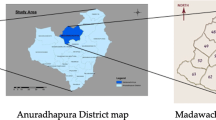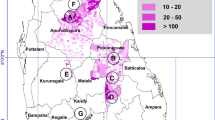Abstract
Intake of heavy metals and metalloids through the diet is posing a big research challenge in Sri Lanka due to the increasing occurrence of chronic kidney disease of unknown aetiology (CKDu) among the farming communities pursuing their livelihoods in the North Central Province (NCP). Duplicated diet studies were conducted on a sample of 62 individuals comprising adult males, adult females, boys, and girls who were selected following a demographic survey in an area of the NCP where there was a high incidence of CKDu. A health risk assessment was made by analysing the heavy metal(loid)s content in the diet samples, by means of inductively coupled plasma mass spectrometry. Rice and vegetables constituted the main diet in the CKDu prevalent areas, with all gender and age categories adhering to similar daily diet patterns. Results of the heavy metal(loid) analysis of duplicated food intake samples indicated that the amounts of Pb in rice, As and Pb in vegetables, and Cd in fish exceeded the recommended daily limits. Because consumption of rice was much higher than the other food items, the estimated daily intake of Pb exceeded the permissible daily intake of 3.5 µg/kgBW/day. There were no significant differences between the age and gender categories in respect of estimated daily intake of Pb, which suggested that the entire population of the study area faced the risk of a high level of Pb exposure. Further, the hazard quotient of Pb was greater than 1. Influence of heavy metal(loid)s on the prevalence of CKDu cannot be understated, and as such interventions are required as a matter of urgency to reduce the local population’s dietary exposure to heavy metal(loid)s.




Similar content being viewed by others
References
Aung, N., Yoshinaga, J., & Takahashi, J. I. (2006). Dietary intake of toxic and essential trace elements by the children and parents living in Tokyo Metropolitan Area. Japan. Food Additives and Contaminants, 23(9), 883–894. https://doi.org/10.1080/02652030600699643
Brzóska, M., & Moniuszko-Jakoniuk, J. (2001). Interactions between cadmium and zinc in the organism. Food and Chemical Toxicology, 39(10), 967–980. https://doi.org/10.1016/S0278-6915(01)00048-5
Chauhan, G., & Chauhan, U. (2014). Human health risk assessment of heavy metals via dietary intake of vegetables grown in wastewater irrigated area of Rewa, India. International Journal of Scientific and Research Publications, 4(9), 1–9.
Coelho, S. D., Pastorinho, M. R., Itai, T., Isobe, T., Kunisue, T., Nogueira, A. J., et al. (2016). Lead in duplicate diet samples from an academic community. Science of the Total Environment, 573, 603–607. https://doi.org/10.1016/j.scitotenv.2016.08.133
Commission Regulation (EU) (2014). Amending Regulation (EC) No 1881/2006 as regards maximum levels of Cadmium in foodstuffs.
Diyabalanage, S., Abekoon, S., Watanabe, I., Watai, C., Ono, Y., Wijesekara, S., et al. (2016). Has irrigated water from Mahaweli River contributed to the kidney disease of uncertain etiology in the dry zone of Sri Lanka? Environmental Geochemistry and Health, 38(3), 679–690. https://doi.org/10.1007/s10653-015-9749-1
FAO/WHO (2004). Joint FAO/WHO expert standards program codex alimentation commission. World Health Oranization. Geneva, Switzerland.
FAO/WHO (2008). Safty evaluation of certain food additives and contaminant. Sixty-eghth meeting of the Joint FAO/WHO Expert Committee on Food Additives, World Health Organization, Geneva, Switzerland.
Fathabad, A. E., Shariatifar, N., Moazzen, M., Nazmara, S., Fakhri, Y., Alimohammadi, M., et al. (2018). Determination of heavy metal content of processed fruit products from Tehran’s market using ICP-OES: A risk assessment study. Food and Chemical Toxicology, 115, 436–446. https://doi.org/10.1016/j.fct.2018.03.044
Herath, H. M. A., Kawakami, T., Nagasawa, S., Serikawa, Y., Motoyama, A., Chaminda, G. G. T., et al. (2018). Arsenic, cadmium, lead, and chromium in well water, rice, and human urine in Sri Lanka in relation to chronic kidney disease of unknown etiology. Journal of Water Health, 16(2), 212–222. https://doi.org/10.2166/wh.2018.070
Huang, S., Liao, Q., Hua, M., Wu, X., Bi, K., Yan, C., et al. (2007). Survey of heavy metal pollution and assessment of agricultural soil in Yangzhong district, Jiangsu Province. China. Chemosphere, 67(11), 2148–2155. https://doi.org/10.1016/j.chemosphere.2006.12.043
Jayasumana, C., Gunatilake, S., & Siribaddana, S. (2015). Simultaneous exposure to multiple heavy metals and glyphosate may contribute to Sri Lankan agricultural nephropathy. BMC Nephrology, 16(1), 103. https://doi.org/10.1186/s12882-015-0109-2
Jayatilake, N., Mendis, S., Maheepala, P., & Mehta, F. R. (2013). Chronic kidney disease of uncertain aetiology: Prevalence and causative factors in a developing country. BMC Nephrology, 14(1), 180. https://doi.org/10.1186/1471-2369-14-180
Jayawardena, R., Thennakoon, S., Byrne, N., Soares, M., Katulanda, P., & Hills, A. (2014). Energy and nutrient intakes among Sri Lankan adults. International Archives of Medicine, 7(1), 34.
JECFA, (2018). Joint FAO/WHO food standars programe codex committee on contaminants in foods. 12th session, Codex Alimenturius Commision, Utrecht, The Netherlands, 12–16 March 2018.
JMP (2013). In S. I. Inc (Ed.), (V13.0 ed.). SAS Campus Drive, Cary, NC, USA.
Khan, S., Cao, Q., Zheng, Y., Huang, Y., & Zhu, Y. (2008). Health risks of heavy metals in contaminated soils and food crops irrigated with wastewater in Beijing. China. Environmental Pollution, 152(3), 686–692. https://doi.org/10.1016/j.envpol.2007.06.056
Khan, N. I., Bruce, D., Naidu, R., & Owens, G. (2009). Implementation of food frequency questionnaire for the assessment of total dietary arsenic intake in Bangladesh: Part B, preliminary findings. Environmental Geochemistry and Health, 31(1), 221–238. https://doi.org/10.1007/s10653-008-9232-3
Lin, X., Zhou, L., Wang, H., Liu, H., Wu, L., Yu, Y., et al. (2018). Accumulation of Heavy Metals in Different Rice Varieties. Huan jing ke xue Huanjing kexue, 39(11), 5198–5206.
Liu, P., Wang, C. N., Song, X. Y., & Wu, Y. N. (2010). Dietary intake of lead and cadmium by children and adults–result calculated from dietary recall and available lead/cadmium level in food in comparison to result from food duplicate diet method. International Journal of Hygiene and Environmental Health, 213(6), 450–457.
Ministry of Health, Labor and Welfare, Government of Japan (2003). Recommended dietary allowances and dietary reference intakes among Japanese. Tokyo: Ministry of Health and Welfare.
Naidu, R., Kookana, R. S., Oliver, D. P., Rogers, S., & McLaughlin, M. J. (2012). Contaminants and the Soil Environment in the Australasia-Pacific Region: Proceedings of the First Australasia-Pacific Conference on Contaminants and Soil Environment in the Australasia-Pacific Region, Held in Adelaide, Australia, 18–23 February 1996: Springer Science & Business Media.
Norton, G. J., Williams, P. N., Adomako, E. E., Price, A. H., Zhu, Y., Zhao, F. J., et al. (2014). Lead in rice: Analysis of baseline lead levels in market and field collected rice grains. Science of the Total Environment, 485, 428–434. https://doi.org/10.1016/j.scitotenv.2014.03.090
Perera, T., & Madhujith, T. (2012). The pattern of consumption of fruits and vegetables by undergraduate students: a case study. Tropical Agricultural Research, 23(3), 261.
Raghunath, R., Tripathi, R., Suseela, B., Bhalke, S., Shukla, V., & Puranik, V. (2006). Dietary intake of metals by Mumbai adult population. Science of the Total Environment, 356(1–3), 62–68. https://doi.org/10.1016/j.scitotenv.2005.04.035
Rahman, M. M., Ng, J. C., & Naidu, R. (2009). Chronic exposure of arsenic via drinking water and its adverse health impacts on humans. Environmental Geochemistry and Health, 31(1), 189–200. https://doi.org/10.1007/s10653-008-9235-0
Rahman, M. A., Rahman, M. M., Reichman, S. M., Lim, R. P., & Naidu, R. (2014). Heavy metals in Australian grown and imported rice and vegetables on sale in Australia: Health hazard. Ecotoxicology and Environmental Safety, 100, 53–60. https://doi.org/10.1016/j.ecoenv.2013.11.024
Rango, T., Jeuland, M., Manthrithilake, H., & McCornick, P. (2015). Nephrotoxic contaminants in drinking water and urine, and chronic kidney disease in rural Sri Lanka. Science of the Total Environment, 518–519, 574–585. https://doi.org/10.1016/j.scitotenv.2015.02.097
Rayman, M. P. (2000). The importance of selenium to human health. The Lancet, 356(9225), 233–241.
Recommonded Dietary Allowances (1989). National Research Council (US) Subcommittee on the Tenth Edition of the Recommended detary allowances. National Academies Press (US), Washington (DC).
Reilly, C. (2002). Metal contamination of food. Its significance for food quality and human health. Blackwell science Ltd, Oxford, UK.
Roychodhury, T., Uchino, T., Tokunaga, H., & Ando, M. (2002). Survey of arsenic in food composites from an arsenic-affected area of West Bengal. India. Food and Chemical Toxicology, 40(11), 1611–1621. https://doi.org/10.1016/S0278-6915(02)00104-7
Shim, J. S., Oh, K., & Kim, H. C. (2014). Dietary assessment methods in epidemiologic studies. Epidemiology and Health. https://doi.org/10.4178/epih/e2014009
Siriwardhana, E. R. I., Perera, P. A., Sivakanesan, R., Abeysekara, T., Nugegoda, D. B., & Weerakoon, K. G. (2014). Is the staple diet eaten in Medawachchiya, Sri Lanka, a predisposing factor in the development of chronic kidney disease of unknown etiology?-A comparison based on urinary β 2-microglobulin measurements. BMC Nephrology, 15(1), 103. https://doi.org/10.1186/1471-2369-15-103
Tajdar-oranj, B., Shariatifar, N., Alimohammadi, M., Peivasteh-roudsari, L., Khaniki, G. J., Fakhri, Y., et al. (2018). The concentration of heavy metals in noodle samples from Iran’s market: Probabilistic health risk assessment. Environmental Science and Pollution Research, 25(31), 30928–30937. https://doi.org/10.1007/s11356-018-3030-y
Thayaruban, T. (2018). Evidences of Heavy Metal Contamination & their Consequences in Sri Lanka with Special Reference to Agriculture: A Review. International Journal of Research in Agriculture and Forestry, 5(8), 14–20.
Ullah, A. A., Maksud, M., Khan, S., Lutfa, L., & Quraishi, S. B. (2017). Dietary intake of heavy metals from eight highly consumed species of cultured fish and possible human health risk implications in Bangladesh. Toxicology Reports, 4, 574–579. https://doi.org/10.1016/j.toxrep.2017.10.002
USEPA (2013). Reference dose (RfD): Description and use in health risk assesments, Background Document 1A, Integrated risk information system (IRIS); United States Environmetal Protection Agency: Washington, DC, http://www.epa.gov/iris/rfd.htm.
Wijayawardena, M. A., Megharaj, M., & Naidu, R. (2017). Bioaccumulation and toxicity of lead, influenced by edaphic factors: Using earthworms to study the effect of Pb on ecological health. Journal of Soils and Sediments, 17(4), 1064–1072. https://doi.org/10.1007/s11368-016-1605-0
Willett, W. C., Koplan, J. P., Nugent, R., Dusenbury, C., Puska, P., & Gaziano, T. A. (2006). Prevention of chronic disease by means of diet and lifestyle changes. In Disease Control Priorities in Developing Countries. 2nd edition: The International Bank for Reconstruction and Development/The World Bank.
Wimalawansa, S. J. (2014). Escalating chronic kidney diseases of multi-factorial origin in Sri Lanka: Causes, solutions, and recommendations. Environ Health Preventive Medicine, 19(6), 375–394. https://doi.org/10.1007/s12199-014-0395-5
Wu, B., Zhao, D., Jia, H., Zhang, Y., Zhang, X., & Cheng, S. (2009). Preliminary risk assessment of trace metal pollution in surface water from Yangtze River in Nanjing Section, China. Bulletin of Environmental Contamination and Toxicology, 82(4), 405–409. https://doi.org/10.1007/s00128-009-9673-0
Xie, Z. M., Chen, J., & Naidu, R. (2013). Not all phosphate fertilizers immobilize lead in soils. Water, Air, & Soil Pollution, 224(12), 1712. https://doi.org/10.1007/s11270-013-1712-0
Acknowledgements
The authors thank the University of Newcastle for the UNIPRS and UNRSC scholarships and higher degree research candidate funding support. We are grateful to the laboratory staff of RARDC, Aralaganwila, Sri Lanka, for the support given in preparing the samples. We also acknowledge GCER and its staff for providing analytical facilities. We are much obliged to Mr. Kim Cloyvas of the University of Newcastle, for his assistance with the statistics.
Author information
Authors and Affiliations
Corresponding author
Ethics declarations
Conflict of interest
The authors firmly declare that they do not have any conflicting financial interests or personal relationships that could have influenced the work reported in this paper.
Ethics approval
This study was approved by the Human Research Ethics Committee (HREC) of the University of Newcastle, Australia and the Ethics Review Committee of the Faculty of Medicine, Rajarata University of Sri Lanka.
Additional information
Publisher's Note
Springer Nature remains neutral with regard to jurisdictional claims in published maps and institutional affiliations.
Rights and permissions
About this article
Cite this article
Kulathunga, M.R.D.L., Wijayawardena, M.A.A. & Naidu, R. Dietary heavy metal(loid)s exposure and prevalence of chronic kidney disease of unknown aetiology (CKDu) in Sri Lanka. Environ Geochem Health 44, 3863–3874 (2022). https://doi.org/10.1007/s10653-021-01144-1
Received:
Accepted:
Published:
Issue Date:
DOI: https://doi.org/10.1007/s10653-021-01144-1




